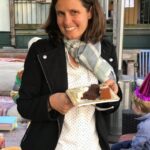Forecasting Nonprofit Finances & Pivoting Programs in a Crisis: Download Spreadsheet
Forecasting is financial prototyping, and it’s a tool that will remain as part of our finance strategy. Download the budget forecast template.

Four steps to keeping a nonprofit flexible and adaptable in tough times.
Though many people see finance as nothing but a collection of terrifying spreadsheets, I see it as the central branch of nonprofit philosophy.
When the pandemic hit, our nonprofit changed everything about the way we work—overnight—and spent the year testing, failing, and trying again. Part of my job as an executive director is to be our organization’s visionary. I knew this meant pushing my overwhelmed brain to imagine what, at the time, seemed like impossible scenarios:
- We would be in lockdown for a year, or likely two.
- We might run out of money.
- We might have to lay off staff.
Here in Silicon Valley, we’ve absorbed one of the local culture’s best ideas: design thinking, which advises creators to brainstorm, prototype, test, fail fast, collect data, and prototype again. So, I tried to keep in mind an even bigger picture:
- What should our nonprofit look like when the pandemic is over?
- How can our programs to continue to serve the ever-growing needs of our community through the pandemic and after?
Every decision I’ve made has been with those two defined goals in mind, even when our programs are losing money, or struggling to reach an audience. Here’s how we pivoted.
1. Forecast for Financial Flexibility
Finance meetings are where we face the Big Questions and come to life-altering conclusions. What should our organization look like? How do we sustain what we like to call at 18 Reasons “the raddest place to work”? How do we live our core values? How do we care for our staff? How can we best serve our community during the biggest crisis of our lifetimes?
During the pandemic, 18 Reasons tossed aside our 2020 budget and relied instead on a forecast, updated monthly, to show us where we were going. Each time we revised our forecast, we puzzled over the same questions, and sometimes came to new conclusions as new data emerged. Liberated from the budget we’d approved in January, we found flexibility and creativity in our monthly revisions. Forecasting is financial prototyping, and it’s a tool that will remain as part of our finance strategy. You can download the tool we developed here and update it with the year and your projected activities.
2. Brainstorm and Prototype Quickly
The stark reality of the situation merged together with our vision for the future. We brainstormed. We rapidly (sometimes overnight!) prototyped. We tested. We collected data. We revised, we prototyped, and tested again. Our commitment to our community kept us motivated, and our flexible financial models kept us focused. Here’s what we did:
- Experiment. On the first day of shelter-in-place, I told our Program Director we should get online classes up and running as fast as possible. We began experimenting wildly with both our free and paid programs in order to transition as fast as possible from in-person to virtual programming.
- Gather partner and community input. With input from the partners who host our free classes, we launched weekly YouTube Live classes, Instagram Live demonstrations, home delivery of groceries and cooking equipment, three-week series, six-week series, infinite series, and drop-in sessions. We hosted Mom’s Corner, where one of our employees cooked live on YouTube with her quaranteen. We partnered with a local grocery store to help senior citizens learn to navigate online grocery ordering. We sent recipes home at school food pickups.
We partnered with local learning hubs (where kids of essential workers could attend school) to deliver lessons via Zoom on a wall-mounted TV, while kids in masks chopped and cooked together. When we didn’t have enough online classes for them to teach, we paid our peer health educators to work in local food pantries. In other words, we just kept trying new things.
- Accept what isn’t working to focus on what is. Did people want classes that taught them what to do with the beans and flour they’d hoarded? Turned out, no.
Now that travel was no longer an option, did they want classes that let them escape to other countries? Sort of. Did they want something for their teens to do during long summer days stuck at home? Definitively YES.
Did families stuck at home want to watch free content on YouTube? Maybe, but we learned we couldn’t really compete with the ocean of free content already available. Did they want live, interactive classes that connected them with people in their community? Absolutely.
Each time an idea flopped, we dissected it, picked out bits and pieces that might work somewhere else, and moved on. In weekly leadership team meetings, we brainstormed, challenged each other’s ideas, and reported on new projects. Pivoting to online programming wasn’t just a one-time event—it was something we engaged in on a daily basis for nearly the entire first year of Covid.
3. Center Humans
Our development director, while always playing a heroic role, transcended human ability this year as she hustled, squeezed, and kept on asking. We upended our org chart and moved every free hour into her department.
While adding more staff resources to the development department seemed like a great idea at first, it created endless management headaches as our development director and staff struggled to stay on top of all the projects and ideas flowing through the department. In retrospect, we should have added one full-time person to the department, instead of squeezing a few hours out of four different staff members.
Constant change is exhausting, and working during a pandemic is incredibly stressful. Our staff are the best of all humans, and our experimental changes over the past year extended to schedules, benefits, and support for self-care. We took off every Friday in July and August. We offered $100 self-care stipends to every employee. We had a Zoom happy hour featuring the three snacks on offer at the beginning of each of our live classes: almonds, olives, and dried apricots. We created, and generously used, our #shoutouts Slack channel, recommended books on #readingrainbow, shared recipes and photos on #cookingthings, and showed off our #officebabies. We shared streaming passwords. We encouraged staff to creatively use time off throughout the year, when traditional vacations didn’t seem to make sense. We welcomed pets and kids in Zoom meetings.
Even as we anticipated losing money in 2021, we gave generous raises in January. The best part of 18 Reasons, the part that ensured we would survive this pandemic and that makes working during it worthwhile, is our people. When we emerge from quarantine, fully vaccinated and ready to share kitchen space again, we will come together knowing this truth.
4. Continue to Diversify
As we made sure to take care of staff, we chased down every last grant opportunity, felt extra grateful for our multi-year funders, and created campaign after campaign. We bottled a signature cocktail and dropped it at sponsors’ houses to sip during a virtual fundraiser. One of our board members had become a sourdough expert during quarantine. We created a campaign called “Bob’s Bake Sale,” where donors who gave $1,000 or more would get a loaf overnighted to them. We took the week before Thanksgiving to run #give18, a campaign that encouraged as many people as possible to give $18 (and then we took Thanksgiving week off—a big win for our staff). We created and sold gingerbread house decorating kits for the holidays. In other words, we kept on diversifying.
Grant funders are not known for their responsiveness, so we knew we would have to lean heavily on individual donors this year. Our donors dug deep to keep us going. We learned the value of a deep donor bench: people who might have given $10 or $25 in a normal year now gave $500 or $1,000. This year gave us the opportunity to try everything, all at once, and while this approach is not sustainable for another year, it helped us set priorities, make the decision to expand our development team, and engage our entire staff in fundraising.
Months into Covid, we began to notice something: Partners around us were slowly conducting surveys to assess community needs, while we had already distributed thousands of pounds of food and created dozens of hours of original content. A year into Covid, a funder asked us, “But how did you know how to do all this?” The answer is, of course, we learned by doing. We used smart tools like financial forecasting to make sure we had a plan and a goal, and rapid prototyping to help us stay creative. By being unafraid to fail, and approaching our work with curiosity and an open mind, we were able to stay true to our mission, continue serving our community, and keep our staff motivated, employed, and passionate.
In case you missed it…
Seeking Sustainability: How Can Nonprofits Survive a Pandemic?
You might also like:
- How to Stop Managing Your Nonprofit and Start Leading
- When the Board Becomes the Problem: Reclaiming Power in Nonprofit Leadership
- Why Human-Centered AI Adoption Matters for Nonprofits
- The New Sheriff in Town: Tips for Successfully Leading a Nonprofit Team (that Someone Else Built)
- When the System Fails Quietly: What I’ve Learned from Sitting Between the Frontline and the Data
You made it to the end! Please share this article!
Let’s help other nonprofit leaders succeed! Consider sharing this article with your friends and colleagues via email or social media.
About the Author
Sarah Nelson has worked on food-related projects in the Bay Area since 2008. In 2011, she founded the nonprofit Three Squares, which merged with 18 Reasons in 2013. In her youth, she taught yoga and guided bicycle tours in France. She is passionate about cooking, rock climbing, riding her bike, family, and, yes, her job. She lives in San Francisco. Contact her at sarah@18reasons.org.
Articles on Blue Avocado do not provide legal representation or legal advice and should not be used as a substitute for advice or legal counsel. Blue Avocado provides space for the nonprofit sector to express new ideas. The opinions and views expressed in this article are solely those of the authors. They do not purport to reflect or imply the opinions or views of Blue Avocado, its publisher, or affiliated organizations. Blue Avocado, its publisher, and affiliated organizations are not liable for website visitors’ use of the content on Blue Avocado nor for visitors’ decisions about using the Blue Avocado website.







